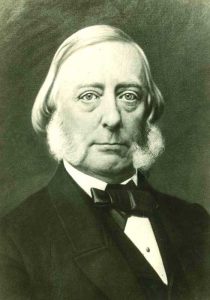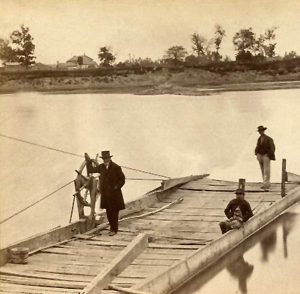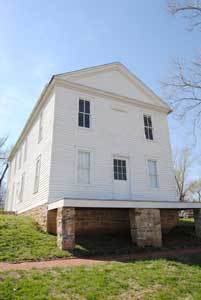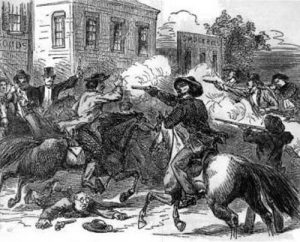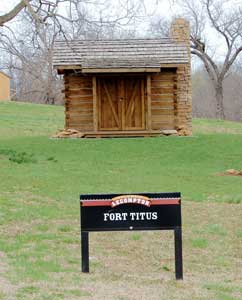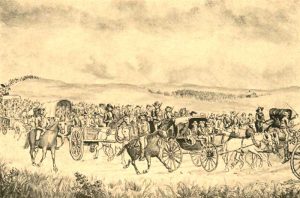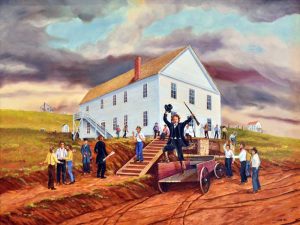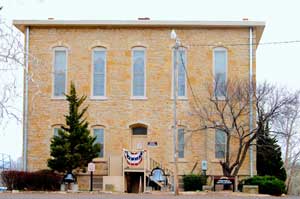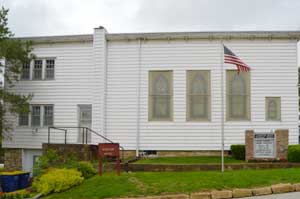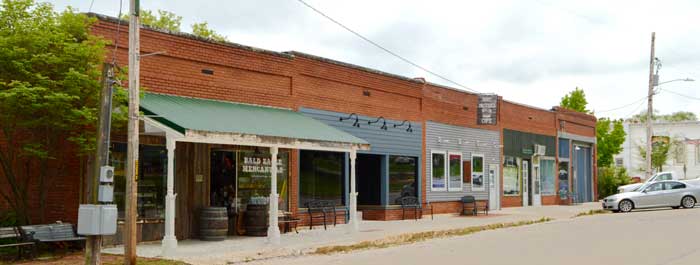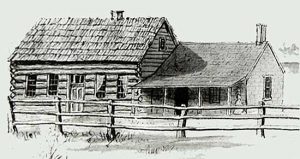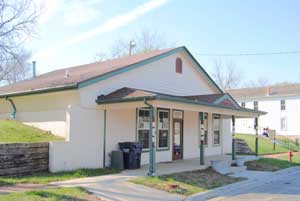Lecompton – Capitol of Kansas Territory – Legends of Kansas (original) (raw)
Lecompton – Capitol of Kansas
Lecompton, Kansas, located on the Kansas River in northwest Douglas County, has a long and rich history, beginning with its being the pro-slavery capital of Kansas Territory.
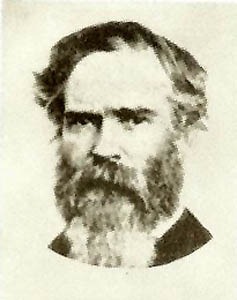
Samuel D. Lecompte
When Kansas Territory was opened for settlement in 1854, some of the first pioneers in the area were A.W. and A.G. Glenn, father, and son; G. W. Zinn, David Martin, M.S. Winter, and William Shirley. The small settlement about 12 miles northwest of Lawrence was initially called “Bald Eagle” but was soon changed to Lecompton in honor of Samuel D. Lecompte, the chief justice of the Territorial Supreme Court.
The Lecompton Town Company was organized at the Potawatomie Agency in 1855, which consisted of several pro-slavery men. In the spring of 1855, the town company held its first meetings in Westport, Missouri, and by May, the townsite, consisting of 600 acres, was surveyed and platted. It was designed to make Lecompton not only the territory’s capital but also a large city. The first house was built of logs by W.R. Simmons in the fall of 1854.
The year 1855 was busy for the new settlement as workers began to construct a new capitol building in the east part of the town on a picturesque site overlooking the Kansas River Valley. In August 1855, the town became the capital of Kansas Territory after President James Buchanan appointed Andrew H. Reeder as governor and charged him and his officials with establishing government offices in Lecompton. It would remain Kansas’s territorial capital and the headquarters of pro-slavery elements in the territory until January 1861.
Governor Andrew Reeder
The town company donated ten acres of land for the capitol grounds. It was to have been a large stone building and, had it been completed, would have cost half a million dollars, provided Congress could have been influenced to continue appropriations. The $50,000 initially provided was quickly spent by the time the basement was completed and the walls up nearly to the height of one story. Work upon it was then discontinued, and the structure as it stood was utilized as a fort.
In the meantime, while the new building was under construction, the Territorial Government, desiring to move from the Shawnee Mission in Johnson County to Lecompton, engaged William M. Nace to erect a suitable building to hold their sessions. Nace began the structure, which stood where the post office would later be built. Subsequently, the Legislature assembled in a two-story frame building across Elmore Street east from where the Rowena Hotel would later be built. The first post office was established in September 1855, and Dr. Aristides Roderigue, the town’s first physician, became the postmaster.
The city soon became a stronghold of pro-slavery politics and southern sympathy, which put it in conflict with nearby Lawrence, founded by Free-Staters from Massachusetts.
Ferry of the Kansas river at Lecompton, Kansas by Alexander Gardner, 1867.
The Legislature, also in 1855, granted authority to establish a ferry across the Kansas River at Lecompton. The same Legislature also incorporated the Lecompton Bridge Company, though no bridge was ever built. That same year, Lecompton was incorporated and designated as the county seat of Douglas County. The same Legislature also incorporated and permanently established the Kansas Medical College at Lecompton and appointed a board of 14 Trustees. However, the college was never established.
John K. Shepherdson opened the first store in the spring of 1856 but soon sold out to a man named William Leamer. James G. Bailey established a second store at about the same time. A large frame hotel called the American Hotel was also built in the spring of 1856, and in the fall, the National Hotel was erected. That same year, the Catholics organized and began building a church and parsonage in the east part of the town. Both were to be of stone, but neither was completed, the partially built walls continuing to stand for the next decade.
Constitution Hall in Lecompton, Kansas, by Kathy Alexander.
The same year, Constitution Hall was built by Samuel J. Jones, sheriff of Douglas County and a notorious pro-slavery champion. The building was a commercial venture designed to house various governmental functions in the newly established capital. A federal land office occupied most of the ground floor, and the upstairs meeting room hosted the organizational convention of the Territorial National Democratic Party, both Lecompton Constitutional Conventions, several sessions of the district and supreme courts, and the first session of the territorial assembly after it came under the control of the antislavery forces.
In subsequent years, the building served many functions, from a college dormitory to a public meeting hall, schoolroom, Undertaker’s Parlor, and lodge hall for fraternal organizations. The hall became a National Historic Landmark in 1974 and a Kansas State Historic Site in 1986. Today it serves as a museum.
In May 1856, the Lecompton Union newspaper was established by A.W. Jones and C.A. Faris. A strong pro-slavery paper. The following paragraph appears in this newspaper, about the Sacking of Lawrence, May 21, 1856, under the following headlines:
The Sacking of Lawrence
“Lawrence Taken! – Glorious Triumph of the Law-and-Order over Fanaticism in Kansas! – Full Particulars.
On Tuesday, the 20th, a large force of the Law-and-Order men having gathered in and around Lecompton, the Marshal ordered the different camps to concentrate about two miles this side of Lawrence, so as to be ready for the execution of his immediate demands upon the people of Lawrence. At this order, we left our sanctum and proceeded to the encampment, equipped for the occasion.”
By the summer of 1856, the political climate of the territory had shifted, and Free-State sympathizers were outnumbering the pro-slavery advocates. Several skirmishes took place in what has become known as Bleeding Kansas.
Fort Titus, Lecompton, Kansas by Kathy Weiser-Alexander.
One of the leading pro-slavery advocates was Colonel Henry T. Titus, who built a fortified log house about two miles south of Lecompton. After Free-State men had destroyed another slavery stronghold called Fort Saunders on August 15, 1856, the Jayhawkers turned their attention to Fort Titus the following day. At dawn, some 400 Free-Staters, divided into two parties, surrounded Fort Titus, and a cannon was pointed directly at the fortified cabin. In the ensuing battle, the Free-State men killed one man and wounded six others, including Colonel Titus.
When the pro-slavery advocates finally surrendered, the Jayhawkers captured some 400 muskets, a large number of knives and pistols, 13 horses, several wagons, supplies and provisions, $10,000 in gold and bank drafts, and 34 prisoners. However, the Jayhawkers also suffered in the battle, with six men wounded and one killed.
The victors then burned Fort Titus to the ground, and the prisoners were taken to Lawrence, where they were “exchanged” on August 18 under a treaty between Governor Wilson Shannon and the Free-State leaders. Today, the Titus cabin has been rebuilt by the Lecompton Historical Society and sits about 100 yards southeast of the Territorial Capital Museum.
General James Lane escorted the legislature to Lecompton in 1857.
In January 1857, the second territorial legislative assembly met at Constitution Hall. Although still firmly pro-slavery, this group removed some of the earlier laws that their antislavery neighbors opposed.
In the fall of 1857, a convention met in Constitution Hall and drafted the famous Lecompton Constitution, which would have admitted Kansas to the Union as a slave state. However, the constitution was rejected after intense national debate. The controversy contributed to the growing dispute in the Civil War. The Lecompton Constitution failed partly because the antislavery party won control of the territorial legislature in the election of 1857. The new legislature met at Constitution Hall and immediately began to abolish the pro-slavery laws. The victorious free-state leaders chose Topeka as the capital when Kansas became a state in 1861.
That year, the Southern Methodist Church of stone and in 1858, the first school in Lecompton would be taught in this building. The Presbyterians also built a church in 1858.
Rowena Hotel in Lecompton, Kansas, in about 1865.
The Rowena Hotel, completed in 1858, was financed by Lecompton investors hoping to convince the territorial legislature to keep the capital in Lecompton. It was advertised as one of the finest hotels in the territory. Business at the Rowena fell off soon after 1861 when the capital was moved to Topeka. The building was sold in 1865 to the United Brethren Church as home to the newly founded Lane University. It continued to be used as a dormitory until 1902 when it became the H.D. Larimer Hardware and Implement Store until 1916. Afterward, it changed hands many times, and by 1947 the building had deteriorated so severely that it had to be demolished. Later, the City of Lecompton purchased the vacant lots where the hotel had once stood and created Rowena Park in 1982.
At the height of its prosperity in 1857-58, Lecompton was quite a flourishing town. By 1858, it had several large hotels, four church organizations, the United States Court, and the U.S. land office. It was also the headquarters for stage lines to Kansas City, Leavenworth, and St. Joseph, Missouri, and was called home to more than 1,000 people. During the years 1856-1858, between 700-1,000 U.S. cavalrymen and territorial militiamen were also stationed in the Lecompton area.
General James Lane at Constitution Hall in Lecompton, Kansas by Ellen Duncan, 1982.
However, it was clear by January 1858 that the pro-slavery advocates in Lecompton and elsewhere were unlikely to win the “war” in Kansas. The progress of Lecompton was quickly halted, and the town soon began to decline. In early 1858, Lecompton lost its county seat status, and all county offices were moved to Lawrence. Before long, homes were removed, some to Lawrence, some to farms, and others went to decay. Fences began to fall down, sidewalks broke up, weeds and underbrush grew in the streets, and all work on public buildings was suspended.
After the Free-State party gained control, the Territorial Legislature continued to meet in Lecompton as the law required but adjourned to Lawrence immediately afterward. The last session met in Lecompton on January 3, 1859.
Though Lecompton was not destined to become the town its founders hoped it would be, Lane University was established by the United Brethren Church in the old Rowena Hotel Building in January 1865. Thirteen acres of the old territorial capitol grounds, together with the abandoned foundation of the capitol building, were donated to the university by the State of Kansas the same year.
Lane University at Lecompton, Kansas by Kathy Weiser-Alexander.
It was named in honor of James H. Lane, United States Senator from Kansas, who was to endow the college but did not live to carry out his promise. During the early days of the college, its support was meager, but the fourth annual conference of the United Brethren church in Kansas and Oklahoma began to improve the institution.
On September 26, 1865, the Kansas New Era newspaper was established at Lecompton. Still, its time was brief in the city, as on May 22, 1867, the paper was moved to Medina in Jefferson County and later to Valley Falls, where it became the Valley Falls New Era.
In 1872, the Atchison, Topeka & Santa Fe Railroad was built through Lecompton, which breathed new life into the waning community. In the early 1880s, the community began to experience more prosperity. However, its population was only about 300. At that time, quite several good, substantial frame houses were built, and other building improvements were made. However, that same year the Presbyterian Church was sold and then used as a private residence. In the meantime, the roof had blown off on the Southern Methodist Church, and part of one side fell down. It was never rebuilt.
In 1882 the United Brethren Church added a two-story building to Lane University on the south half of the old unfinished capital foundation.
The Methodist Church in Lecompton, Kansas, was once the Windsor Hotel by Kathy Alexander.
In 1884, a large drugstore was built by B.H. Leslie. In 1903, the building was remodeled and renamed the Windsor Hotel. In 1921, it was purchased by the United Brethren Church. Many years later, in 1968, it became the Lecompton United Methodist Church with the merger of the town’s United Brethren and Methodist Churches.
In 1891 Lane University was again expanded to embrace preparatory, normal, commercial, and college departments, a divinity school, and special departments of music and elocution. By 1900, however, the school’s population had fallen to 178 students and 11 faculty members. In 1902, it was merged with Campbell University to form Campbell College and moved to Holton, Kansas. The building was then used as a high school until a new one was built in 1927. Today Lane University is a museum known as Lane University & Territorial Capital Museum, dedicated to Kansas history before the Civil War. It is listed on the National Register of Historic Places.
Old Highschool in Lecompton, Kansas by Kathy Alexander.
In 1910, Lecompton had a money order post office, telegraph and express facilities, several retail establishments, and reported a population of 386. The small town suffered a blow in 1916 when the east side of its main street (Elmore) was destroyed by fire. Though some buildings were replaced with brick structures, others were never rebuilt. Many of these structures still stand.
A new Lecompton Rural High School was built in 1927 and continued to serve students until 1970. Still standing, the building is owned by the City of Lecompton.
Over the years, Lecompton remained a small town and is now a “bedroom community” serving primarily commuters into Lawrence and Topeka. The area population is about 650 today.
Several historical sites remain in Lecompton to tell of its fascinating history, including the Lane University & Territorial Capital Museum; Constitution Hall, a Kansas state historic site; the old Democratic Headquarters, the rebuilt Fort Titus, and several historic buildings, including the old Radical United Brethren Church which now serves as a community building. Lecompton is located about 12 miles northwest of Lawrence. Take U.S. Highway 40 west from Lawrence for about eight miles, then turn right on E 600th Road to Lecompton.
Lecompton, Kansas Business District today by Kathy Alexander.
Contact Information:
Historic Lecompton
Lecompton Historical Society
640 E. Woodson
Lecompton, Kansas 66050
785-887-6285 or 785-887-6148
Lecompton, Kansas Democratic headquarters, 1877
Lecompton, Kansas Democratic Headquarters today by Kathy Alexander.
This stone building was the headquarters of the Democratic Party during the Kansas Territorial period (1854-1861). Built in the 1850s by Italian stonemason Mark Migilario, possibly the first dwelling in Lecompton and the residence of William Simmons and his son Thomas who made their living fishing and operating a ferry on the Kansas River. The building was once attached to a log cabin that has long since disappeared. Later, the Atchison, Topeka & Santa Fe Railroad acquired the building before it fell into private hands. Today, it is owned by the Lecompton Historical Society.
Lecompton, Kansas City Hall by Kathy Alexander.
Compiled and edited by Kathy Alexander/Legends of Kansas, updated January 2023.
Also See:
Bleeding Kansas & the Missouri Border War
Kansas-Missouri Border War Timeline
Territorial Kansas & the Struggle for Statehood
Sources:
Blackmar, Frank W.; Kansas: A Cyclopedia of State History, Standard Publishing Company, Chicago, IL 1912.
Cutler, William; History of the State of Kansas, A.T. Andreas, Chicago, IL, 1883.
Historic Lecompton
Wikipedia

